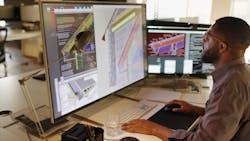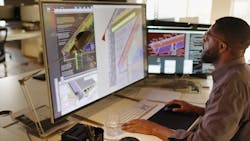From Building Design to Technology Application
Building architectural design seems to conflict with the requirements of the security designer. Architectural firms are bridled with the entire scope of a building design and must consider every aspect of the built environment, from what is seen in the design elements of the façade and interior to the unseen structural, mechanical, and electrical components, to the functional aspect of how occupants will use the spaces. All whilst seeing their fees reduced in order to stay competitive in a market where owners expect to pay less for professional services they view as a commodity of the building they are purchasing. Security elements, unless a priority of the owner as a prerequisite for an acceptable design, are fighting to be heard in an ever-growing list of design requirements. This defines the issue facing the future of converged building design.
As we have moved into a new era of interoperability and integrated infrastructure that is being built on the digital domain and network infrastructure, it is becoming obvious that something must change. The increasing dependency on network and communication systems to manage and secure buildings has become less of a want to have and more of a need to have. This has led to a greater need for technology to be defined as part of an integrated design.
Security Must Be a Part of a Holistic Design Approach
The architectural community and AIA understand this but struggle to incorporate design teams from the security side due to a lack of understanding of when certain decisions are made along the architectural design process. A complete security plan cannot be incorporated into an architectural design that is still in development, changes will be required along with the flexibility to make those changes. Security design teams are more likely to establish that security is required based on defense-in-depth theory, which at times can be at odds with the desired aesthetics in architecture. Only through a holistic approach, where both sides understand and respect the other’s needs, is it possible to create unified designs.The threshold from building design to technology application is the use of security by design principles that are based on true and tried concepts. Most revolve around the network infrastructure and how it is designed as the basis for technology deployment. This incorporates well-positioned Main Distribution Frame (MDF) and Independent Distribution Frame IDF) rooms to propel the communication infrastructure for cameras, access control, sensors, communication, and audio-visual systems. These design concepts are based on building design teams that cooperate and communicate effectively through the design process, allowing the architect to make changes in an efficient manner.
For example, locating the MDF and IDF rooms should happen early in the design process, well before a part of the security systems is designed, and can be placed based on the known requirements of how far any piece of technology can be located from them. When trying to locate these spaces after the building layout is well established, concessions must be made either to the functionality of the space or the infrastructure. Likewise, when the security design team is working on a BIM file and they locate their cameras or readers on a wall, they must recognize that the wall could move or be eliminated requiring redesign efforts on their part. Alleviating frustration is the first step to a successful security-by-design build-out.
The Experts Chip In
Design principles set forth by Crime Prevention Through Environmental Design (CPTED) have created a path for Architects and Security design teams to work together to define the greater good in safety and security. Finding the commonalities between the often-opposing design requirements allows for continued cooperation between the Architect and Security professionals. IT teams and the electrical contractor community have also been an impediment to the cooperative nature needed to create a unified design.
“The absence of clear legal frameworks around the integration of security measures within the International Building Code creates a challenge for architects and designers seeking to take a holistic approach around the use of Resilient Practices and Security Systems in building infrastructures. Without well-defined guidelines, professionals are left to navigate an ambiguous path, relying on guesswork to determine the best practices,” says Paula Balmori, Global Director of Security Design at Brivo, U.S. CPTED Association Director and Chair of the Secure Building Council. “Consequently, the building industry remains unaware of the immense benefits associated with taking a proactive stance in mitigating risks during project development, resulting in developers frequently encountering financial losses, time constraints, and depreciation of property value.”
Each stakeholder within the initial phase of the design tends to operate in silos and this does not help bring technological ecosystems together. Breaking down these silos must be done by coordinating all teams and their objectives so that best practices can become visualized.
“As we envision the future of building design, it is paramount to strike a productive balance between architectural aesthetics and the imperative of safety, security, and operational efficiency. We understand the inherent value in integrating advanced communication systems within the very fabric of a building's design,” concludes Tom Reilly, President of Commend USA. “By embracing the principles of elegant design, CPTED, and leveraging cutting-edge technologies, we empower organizations to reinforce their infrastructure, enhance operational efficiency, and gain invaluable data and intelligence that transcends traditional security measures. This symbiotic relationship between design and security reinforces our commitment to creating safer, smarter, and more resilient spaces for the future.”
By embracing the principles of elegant design, CPTED, and leveraging cutting-edge technologies, we empower organizations to reinforce their infrastructure, enhance operational efficiency, and gain invaluable data and intelligence that transcends traditional security measures. This symbiotic relationship between design and security reinforces our commitment to creating safer, smarter, and more resilient spaces for the future.”
Technology cannot cross the chasm unless all the stakeholders work together to understand the outcomes. As we move towards greater use of technology to gain data and intelligence across a building infrastructure we rely on a “value in design” which defines technology as a roadmap for value to business process as well as security and safety requirements while maintaining architectural aesthetics.
About the Author

Pierre Bourgeix
CEO of ESI Convergent
Pierre Bourgeix is Chief Executive Officer of ESI Convergent, a management consulting firm focused on helping companies assess and define the use of people, processes, and technology within the physical security and cybersecurity arenas. He has spent 30 years as a global security consultant and innovator through his experience with Rand Corporation, U.S. State Department, ADT/Tyco Security, HySecurity, Wallace International, SecureState, and Boon Edam.

Benjamin Crum
President of Architectural Security Design Group
Ben Crum is the President of Architectural Security Design Group and works with owners, architects, and security consultants, to employ a holistic design approach incorporating security design principles into the early stages of the architectural design process. Recognized as a security specialist, he holds the Physical Security Professional, CPTED Professional Designation, and NFPA 3000 Program Specialist certifications. He serves on the Advisory Board for the Partner Alliance for Safer Schools, ASIS International’s School Safety & Security Council, and as a Director for the US CPTED Association.
Ben is a registered architect with a NCARB Certification and served as Director of Design for a multi-office architectural firm where he participated in the majority of the firm’s projects during the schematic and design phases. With over 15 years of experience working on a variety of building types including Educational, Commercial, Multifamily Housing, and Development, he brings a diverse experience to every project he is a part of.



